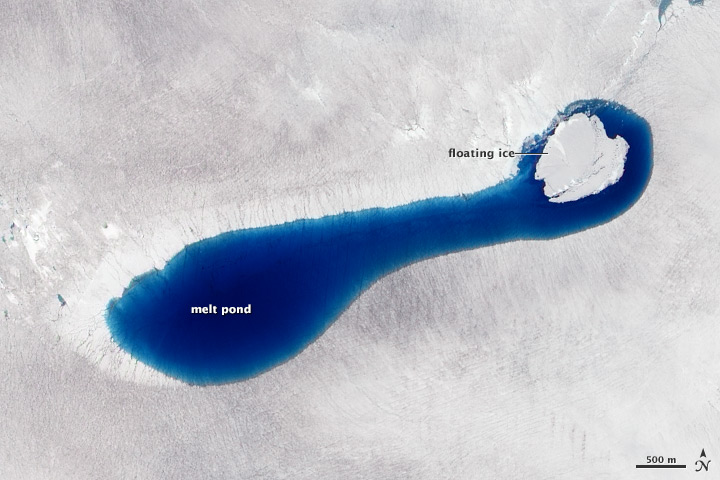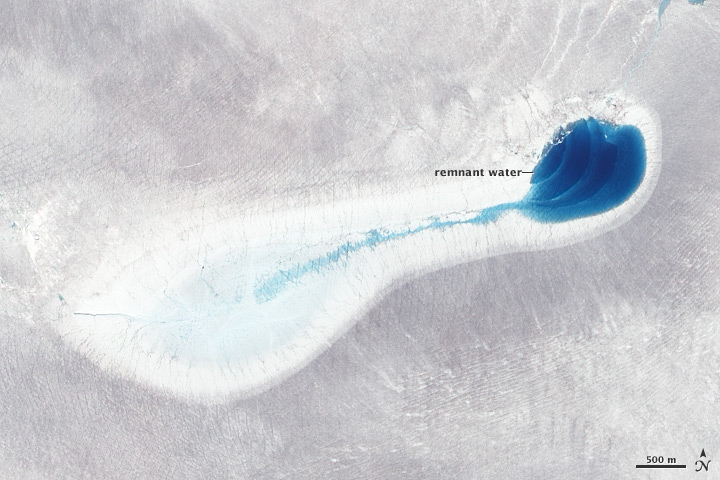NASA: Greenland Melt Ponds - 30.03.13
Posted by Ricardo Marcenaro | Posted in NASA: Greenland Melt Ponds - 30.03.13 | Posted on 20:47

acquired June 3, 2010
download large image (3 MB, JPEG, 4224x4224)

acquired July 4, 2010
download large image (3 MB, JPEG, 4224x4224)

acquired August 17, 2010
download large image (3 MB, JPEG, 4224x4224)
acquired June - August, 2010
download Google Earth file (KML)
Each spring and summer, as the air
warms up and the sunlight beats down on the Greenland ice sheet,
sapphire-colored ponds spring up like swimming pools in a suburban
neighborhood. As snow and ice melt atop the glaciers, the water flows in
channels and streams and collects in depressions on the surface that are sometimes visible from space. These melt ponds and lakes sometimes disappear quickly—a phenomenon that scientists have observed firsthand in recent years.
The three natural-color images above were acquired on June 3, July 4, and August 17, 2010, by the Advanced Land Imager on NASA’s Earth Observing-1 (EO-1) satellite. This glacial ice field lies in southwestern Greenland, not far from Disko Bay (Disko Bugt in Danish) and Davis Strait. The center of the image is 68.91° North latitude and 48.54° West longitude.
In early summer, streams of melt water cross the scene, though it is unclear if they are flowing west or east. The water pools in two depressions in the ice, which often has a surface topography that reflects the earthen hills and valleys below. By midsummer, the two ponds merge into one and take on the dark blue of deep water—deep enough to float an ice raft. By mid-August, the melt pond is mostly empty, likely from the opening of a deep crack, or “moulin,” in the bottom of the basin. The extent of the melt water at its highest level is still visible as bright white ice.
Glaciologists and ocean scientists are interested in moulins, which act like plumbing drains and pipes moving melted water from the surface to the bottom of the ice sheet and eventually to the coast. Greenland’s glaciers have been accelerating their movement and calving in recent decades, and some scientists have theorized that the melt water lubricates the interface between the ice sheet and rocky landscape, allowing glaciers to move faster.
In a study published in February 2013, researchers led by Dave Chandler and Jemma Wadham of the University of Bristol found that melt water appears to flow through distinct channels under the ice. The team injected harmless gas and liquid chemical tracers (rhodamine and sulphur hexafluoride) into the melt ponds and moulins on Leverett Glacier in several episodes over a three-year period. They followed the flow toward the coast for as much as 57 kilometers (35 miles) and found that the melt water is not necessarily lubricating wide areas of the ice sheet bed.
In another 2013 study led by Maya Bhatia of the University of British Columbia and the Woods Hole Oceanographic Institution, scientists found that the melt water pouring out of Greenland’s icy plumbing system is carrying significantly more dissolved iron than previously thought. In fact, it may be spreading as much iron into the Arctic and North Atlantic Oceans as typically gets deposited there by airborne dust. Iron is a key nutrient for phytoplankton, so enrichment through glacier melting could lead to more extensive or frequent blooms.
Researchers participating in NASA’s IceBridge airborne mission will return to Greenland this week to resume aerial surveys of ice sheet thickness, glacier melting, and other aspects of the changing northern landscape. Read more by clicking here.
The three natural-color images above were acquired on June 3, July 4, and August 17, 2010, by the Advanced Land Imager on NASA’s Earth Observing-1 (EO-1) satellite. This glacial ice field lies in southwestern Greenland, not far from Disko Bay (Disko Bugt in Danish) and Davis Strait. The center of the image is 68.91° North latitude and 48.54° West longitude.
In early summer, streams of melt water cross the scene, though it is unclear if they are flowing west or east. The water pools in two depressions in the ice, which often has a surface topography that reflects the earthen hills and valleys below. By midsummer, the two ponds merge into one and take on the dark blue of deep water—deep enough to float an ice raft. By mid-August, the melt pond is mostly empty, likely from the opening of a deep crack, or “moulin,” in the bottom of the basin. The extent of the melt water at its highest level is still visible as bright white ice.
Glaciologists and ocean scientists are interested in moulins, which act like plumbing drains and pipes moving melted water from the surface to the bottom of the ice sheet and eventually to the coast. Greenland’s glaciers have been accelerating their movement and calving in recent decades, and some scientists have theorized that the melt water lubricates the interface between the ice sheet and rocky landscape, allowing glaciers to move faster.
In a study published in February 2013, researchers led by Dave Chandler and Jemma Wadham of the University of Bristol found that melt water appears to flow through distinct channels under the ice. The team injected harmless gas and liquid chemical tracers (rhodamine and sulphur hexafluoride) into the melt ponds and moulins on Leverett Glacier in several episodes over a three-year period. They followed the flow toward the coast for as much as 57 kilometers (35 miles) and found that the melt water is not necessarily lubricating wide areas of the ice sheet bed.
In another 2013 study led by Maya Bhatia of the University of British Columbia and the Woods Hole Oceanographic Institution, scientists found that the melt water pouring out of Greenland’s icy plumbing system is carrying significantly more dissolved iron than previously thought. In fact, it may be spreading as much iron into the Arctic and North Atlantic Oceans as typically gets deposited there by airborne dust. Iron is a key nutrient for phytoplankton, so enrichment through glacier melting could lead to more extensive or frequent blooms.
Researchers participating in NASA’s IceBridge airborne mission will return to Greenland this week to resume aerial surveys of ice sheet thickness, glacier melting, and other aspects of the changing northern landscape. Read more by clicking here.
References
- Bhatia, M.P. et al (2013, March 10) Greenland meltwater as a significant and potentially bioavailable source of iron to the ocean. Nature Geoscience.
- Chandler, D.M. et al (2013, February 24) Evolution of the subglacial drainage system beneath the Greenland Ice Sheet revealed by tracers. Nature Geoscience 6, 195–198.
- NASA Earth Observatory (2007, April 7) Melt Ponds on Greenland’s Ice Cap.
- University of Bristol (2013, March 13) Tracers study reveals rivers beneath the Greenland Ice Sheet. Accessed March 20, 2013.
- Woods Hole Oceanographic Institution (2013, March 10) Glaciers Contribute Significant Iron to North Atlantic Ocean. Accessed March 20, 2013.
- Woods Hole Oceanographic Institution (2008, July 7) Crack! A Lake Atop Greenland Disappears. Oceanus. Accessed March 20, 2013.
- Woods Hole Oceanographic Institution (2005, December 15) Tracking an Ocean of Ice Atop Greenland. Oceanus. Accessed March 20, 2013.
NASA Earth Observatory image by Jesse Allen and Robert Simmon, using EO-1 ALI data from the NASA EO-1 team.
Caption by Mike Carlowicz, with interpretation help from Sarah Das,
Woods Hole Oceanographic Institution, and Marco Tedesco, City University
of New York.
- Instrument:
- EO-1 - ALI


Comments (0)
Publicar un comentario